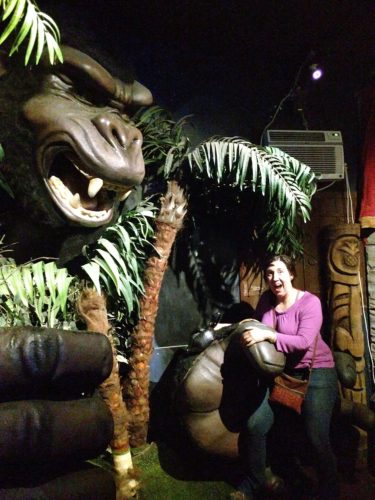
Photo of me at the Museum of the Weird in Austin, Texas
Today we’re talking about how to hook your readers from the very beginning of your book. When we talked about Elmore Leonard’s rules on writing a while ago, we noted that one of his rules is to never start a book describing the weather. It’s boring and doesn’t do much to hook the reader, unless you’re describing something akin to a terrible storm where people struggle to survive.
And I also told you that you need a good way of hooking the reader so that he keeps turning pages, and provided some examples of great first paragraphs.
Writer’s Digest also has a helpful article on ways to hook your reader. The article notes that these techniques also work for nonfiction books. If you’re writing nonfiction, you’re usually trying to help readers solve a problem, and the hook will revolve around that idea. If you’re writing fiction, your writing should compel readers to turn the pages and finish the book. The pace of your book should be quick and efficient. To that end, it helps to avoid long sentences and overly long paragraphs. You should also keep chapters short.
Writer’s Digest notes, “If a writer wants a writing career, we need to practice the craft of both hooking and keeping; it’s not about the one-night stand, it’s about the relationship.” You’ve got to maintain a good pace throughout the entire book, not just at the beginning.
Also:
“Hooking a reader is all about keeping them interested by using craft to paint a compelling picture. If you consider the ten items that help build tension and move the story forward, writers can weave a tale that keeps readers up at night and that is the magic in the best of relationships.”
The author of the Writer’s Digest article used hooks when writing a nonfiction essay, which shows you that these techniques aren’t just for fiction.
Here are the ten techniques from the article:
- Begin at a pivotal moment
- Add an unusual situation
- Add an intriguing character (e.g., Sherlock Holmes, one of my favorites!)
- Conflict (this is useful for both fiction and nonfiction)
- Add an antagonist
- Change emotion
- Irony and surprise
- Make People Wonder (this is probably my favorite and one I use all the time, mostly because I’m a curious Gemini and always want to figure things out and see what happens!)
- Dread Factor (maybe this explains why so many of us love true crime shows!)
- Keep narrative voice compelling (use description; show, don’t tell; and write short, crisp sentences!)
I strongly encourage you to check out the entire Writer’s Digest article and explore how the author uses the above techniques in her nonfiction essay.
Which of these techniques are your favorites? Let me know by email or in the comments.
Happy Writing!
Get helpful writing tips and more
in your inbox
Join the tribe and get free fiction and self-publishing tips.
Thank you for subscribing.
Something went wrong.

Be First to Comment